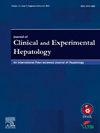The Role of Stereotactic Body Radiation Therapy in the Outcomes of Intrahepatic Recurrent Small Hepatocellular Carcinoma
IF 3.2
Q2 GASTROENTEROLOGY & HEPATOLOGY
Journal of Clinical and Experimental Hepatology
Pub Date : 2025-03-28
DOI:10.1016/j.jceh.2025.102561
引用次数: 0
Abstract
Background and aim
To retrospectively evaluate the role of stereotactic body radiation therapy (SBRT) played for the outcomes of intrahepatic recurrent small hepatocellular carcinoma (HCC).
Methods
We collected 51 intrahepatic recurrent ≤5 cm small HCC patients between January 2016 and December 2021. SBRT was given as 4–5 fractions with 32.5–50Gy. The baseline data of the patients and the radiotherapy strategy data were collected and survival analyses were performed among these factors. The outcomes comprised overall survival (OS), freedom from local progression (FFLP), and progression-free survival (PFS), with the 95% confidence interval (95%CI). The follow-up time was calculated from the date of the SBRT to the date of the last follow-up communication, hospitalization, or death. Survival analysis was conducted by the Kaplan–Meier methods and log-rank test.
Results
The median follow-up time was 48 months (range: 4.8–90). The 1-year, 3-year, and 5-year OS rates of the overall cohort were 95.9% (95%CI: 0.905–1.000), 84.9% (95%CI: 0.751–0.959) and 69.1% (95%CI: 0.553–0.862), respectively. The 1-year, 3-year, and 5-year FFLP rates of the overall cohort were 97.5% (95%CI: 0.928–1.000), 82.0% (95%CI: 0.697–0.965), and 72.8% (95%CI: 0.578–0.918), respectively. The 1-year, 3-year, and 5-year PFS rates of the overall cohort were 85.7% (95%CI: 0.758–0.970), 43.4% (95%CI: 0.296–0.635), and 27.3% (95%CI: 0.149–0.498), respectively. The 5-year FFLP rate of lesions less than 2 cm [72.5% (95%CI: 0.52–1)] and those 2–5 cm [71.9% (95%CI: 0.514–0.976)] were similar. We suggested that the lesions received 45Gy/50Gy with 5 fractions were associated with a higher 5-year FFLP rate [74.6% (95%CI: 0.57–0.976)] than 40Gy/5F [40.0% (95%CI: 0.137–1)].
Conclusion
We found SBRT was effective in patients with lesion size of 2–5 cm, with similar results in those with tumor size of 0–2 cm. We suggested that the lesions received over 85.5Gy of biological effective dose with α/β = 10Gy were associated with a higher FFLP.

立体定向放射治疗在肝内复发小肝细胞癌预后中的作用
背景与目的回顾性评价立体定向放射治疗(SBRT)对肝内复发性小肝细胞癌(HCC)预后的影响。方法收集2016年1月~ 2021年12月肝内复发≤5 cm的小HCC患者51例。SBRT分4 ~ 5次给药,剂量为32.5 ~ 50gy。收集患者的基线数据和放疗策略数据,并对这些因素进行生存分析。结果包括总生存期(OS)、无局部进展(FFLP)和无进展生存期(PFS), 95%可信区间(95% ci)。随访时间从SBRT日期计算到最后一次随访通信、住院或死亡日期。生存率分析采用Kaplan-Meier法和log-rank检验。结果中位随访时间为48个月(4.8 ~ 90个月)。整体队列的1年、3年和5年OS率分别为95.9% (95%CI: 0.905-1.000)、84.9% (95%CI: 0.751-0.959)和69.1% (95%CI: 0.553-0.862)。整个队列的1年、3年和5年FFLP率分别为97.5% (95%CI: 0.928-1.000)、82.0% (95%CI: 0.697-0.965)和72.8% (95%CI: 0.578-0.918)。总体队列的1年、3年和5年PFS率分别为85.7% (95%CI: 0.758-0.970)、43.4% (95%CI: 0.296-0.635)和27.3% (95%CI: 0.149-0.498)。小于2 cm的5年FFLP率[72.5% (95%CI: 0.52-1)]与2 - 5 cm的[71.9% (95%CI: 0.514-0.976)]相似。我们认为,5组45Gy/50Gy的病变5年FFLP率[74.6% (95%CI: 0.57-0.976)]高于40Gy/5F的病变[40.0% (95%CI: 0.137-1)]。结论SBRT对肿瘤大小为2-5 cm的患者有效,对肿瘤大小为0-2 cm的患者效果相似。我们认为,当α/β = 10Gy时,生物有效剂量超过85.5Gy的病变与较高的FFLP相关。
本文章由计算机程序翻译,如有差异,请以英文原文为准。
求助全文
约1分钟内获得全文
求助全文
来源期刊

Journal of Clinical and Experimental Hepatology
GASTROENTEROLOGY & HEPATOLOGY-
CiteScore
4.90
自引率
16.70%
发文量
537
审稿时长
64 days
 求助内容:
求助内容: 应助结果提醒方式:
应助结果提醒方式:


